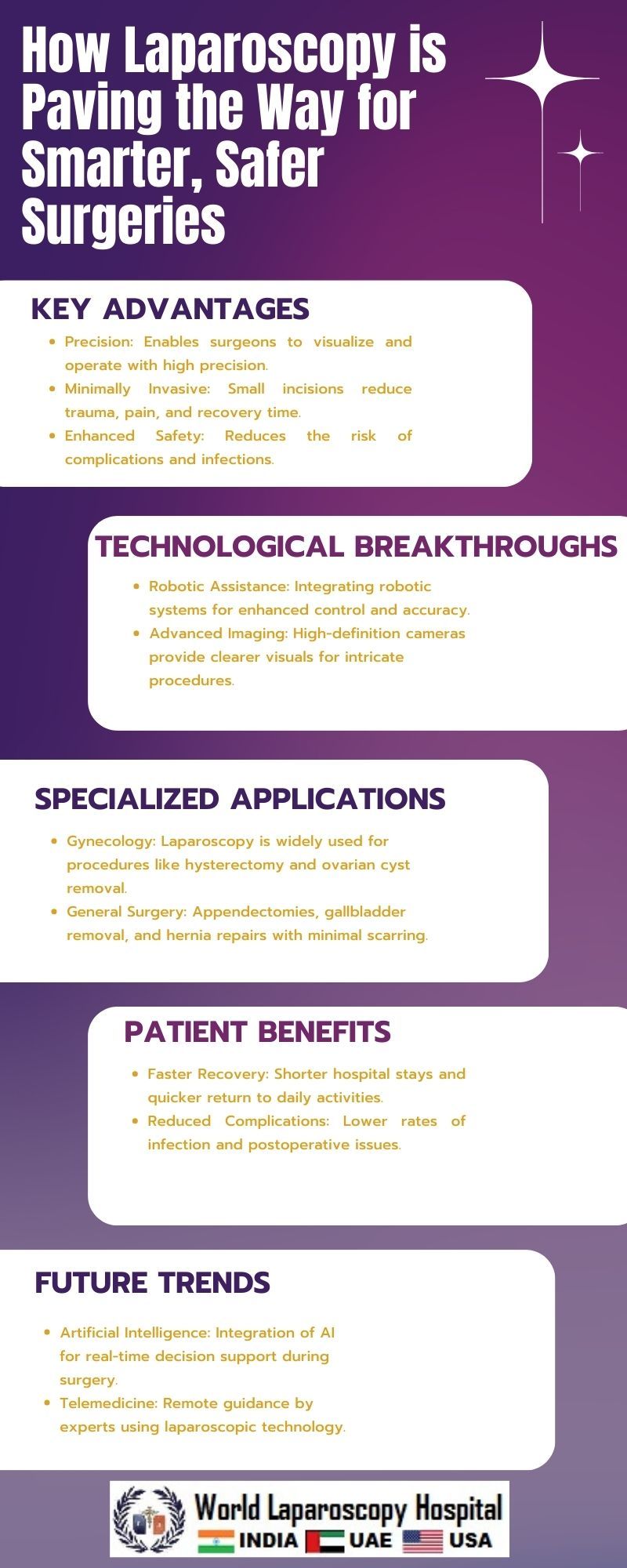How Laparoscopy is Paving the Way for Smarter, Safer Surgeries
Introduction:
In the ever-evolving landscape of medical advancements, laparoscopy has emerged as a transformative force, reshaping the realm of surgeries. This minimally invasive technique, commonly known as keyhole surgery, employs small incisions and specialized instruments, offering numerous benefits over traditional open surgeries. As we delve into the intricate details of laparoscopy, it becomes evident that its impact goes far beyond the operating room, influencing patient outcomes, recovery times, and the very essence of surgical precision.

The Evolution of Laparoscopy:
Laparoscopy's journey can be traced back to the early 20th century, with pioneers like George Kelling and Hans Christian Jacobaeus experimenting with the concept. However, it wasn't until the latter half of the century that laparoscopy gained widespread acceptance. Technological innovations, such as fiber optics and video cameras, played a pivotal role in overcoming initial challenges and enhancing visualization during procedures.
Today, laparoscopy has evolved into a sophisticated surgical approach, enabling surgeons to perform intricate procedures with unparalleled precision. The technique involves making small incisions through which a camera and specialized instruments are inserted, providing real-time visual feedback on a monitor. This visual access to the surgical field has revolutionized various medical specialties, from general surgery to gynecology, urology, and beyond.
Key Advantages of Laparoscopy:
Minimal Invasiveness:
Laparoscopy's hallmark is its minimally invasive nature, as it replaces large incisions with several smaller ones. This significantly reduces trauma to the body, resulting in less pain, minimal scarring, and faster recovery times for patients. The cosmetic benefits alone contribute to an improved patient experience.
Enhanced Visualization:
The integration of high-definition cameras into laparoscopic systems has transformed visualization during surgeries. Surgeons now have a magnified, crystal-clear view of the operating field, allowing for better identification of anatomical structures and precise maneuvering of instruments. This enhanced visibility is particularly crucial in delicate procedures.
Reduced Blood Loss:
Compared to traditional open surgeries, laparoscopic procedures often involve less blood loss. The minimization of blood loss is attributed to the smaller incisions, as well as the cauterization capabilities of some laparoscopic instruments. This advantage is especially significant in surgeries where blood loss poses a critical risk.
Quicker Recovery Times:
Patients undergoing laparoscopic procedures typically experience shorter hospital stays and faster recovery times compared to those undergoing traditional surgeries. The reduced trauma to tissues, coupled with the benefits of smaller incisions, allows individuals to resume their normal activities sooner, enhancing overall postoperative quality of life.
Lower Infection Rates:
The risk of postoperative infections is diminished with laparoscopy, as smaller incisions minimize exposure of internal organs to external contaminants. This reduction in infection risk is a crucial factor in promoting patient safety and preventing complications that may arise during the recovery period.
Technological Innovations in Laparoscopy:
As laparoscopy continues to gain prominence, technological innovations play a pivotal role in refining and expanding its capabilities. Some notable advancements include:
Robotic Assistance:
Robotic-assisted laparoscopy has emerged as a game-changer in surgical precision. Robotic systems, such as the da Vinci Surgical System, provide surgeons with enhanced dexterity, 3D visualization, and the ability to perform complex maneuvers with unparalleled accuracy. The synergy between human skill and robotic assistance opens new frontiers in minimally invasive surgery.
Advanced Imaging Modalities:
The integration of advanced imaging technologies, such as fluorescence imaging and augmented reality, further enhances the surgeon's ability to visualize structures during laparoscopic procedures. Real-time feedback, coupled with overlays of critical information, elevates the precision and safety of surgeries.
Artificial Intelligence in Surgical Planning:
Artificial intelligence (AI) is making inroads into laparoscopy by aiding in preoperative planning. AI algorithms can analyze patient data, imaging studies, and historical surgical outcomes to provide personalized insights. This not only optimizes surgical approaches but also contributes to more accurate risk assessment and tailored treatment strategies.
Challenges and Future Directions:
While laparoscopy has undoubtedly transformed the landscape of surgeries, challenges persist, and ongoing research aims to address them. Some key challenges and potential future directions include:
Learning Curve:
Mastering laparoscopic techniques requires a significant learning curve for surgeons. Training programs and simulators are continually evolving to bridge this gap and ensure that surgeons can seamlessly transition to minimally invasive approaches.
Cost Considerations:
The initial costs associated with laparoscopic equipment and robotic systems can be substantial. However, as technology advances and becomes more widespread, there is an expectation that costs will decrease, making these techniques more accessible to a broader range of healthcare institutions.
Expanding Applications:
Efforts are underway to expand the applications of laparoscopy to more complex and intricate surgeries. Innovations in instrument design, coupled with advancements in robotic technology, are facilitating the exploration of new frontiers, including procedures that were once deemed too challenging for minimally invasive approaches.
Global Accessibility:
Access to laparoscopic procedures varies globally, with resource constraints affecting the adoption of advanced technologies in some regions. Initiatives aimed at improving global accessibility to laparoscopic surgeries and associated technologies are crucial for ensuring equitable healthcare outcomes.
Conclusion:
Laparoscopy has undeniably transformed the landscape of surgeries, offering a paradigm shift towards smarter, safer, and more patient-centric healthcare. From its humble beginnings to the integration of cutting-edge technologies, this minimally invasive approach continues to redefine the possibilities within various medical specialties. As researchers, surgeons, and technology developers collaborate, the future holds the promise of even more refined and accessible laparoscopic techniques, further elevating the standard of care for patients worldwide.
